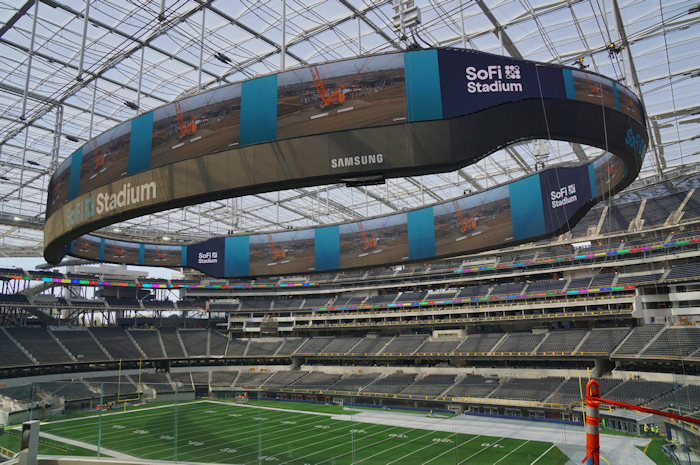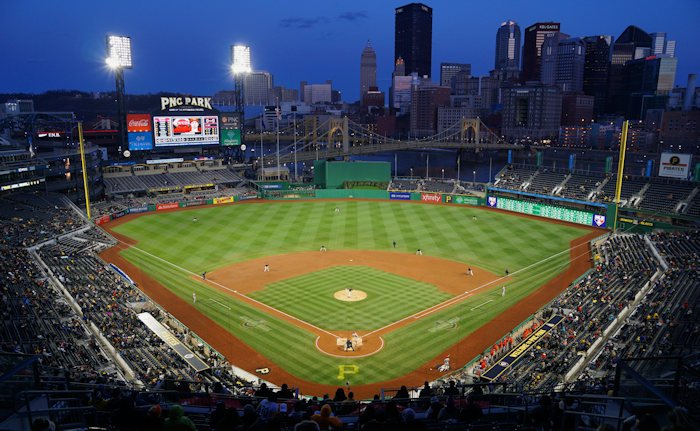Note: when it came time to write my 100th article to run in a USA TODAY publication, my longtime editor and I decided to do something different: provide my choice for the best venue in each pro sport right now. Here is the article that appeared in the 11/29/23 issue of USA TODAY Sports Weekly:
by Joe Mock
All rights reserved
In determining my best venue in each sport, I’m avoiding the temptation to list my favorite facilities of all time. Instead, I am focusing on the present day. Does that mean there is “recency bias” in my choices? Absolutely, because modern-day design and construction typically produce more amenities for fans, improving the experience of attending games.
For each pro sport, there are three finalists, with the winner in bold. Let the arguments begin!
MLS
The contenders:
Allianz Field (2019), Minnesota United FC
Q2 Stadium (2021), Austin FC
TQL Stadium (2021), FC Cincinnati

When Major League Soccer mandated that its clubs must play in soccer-specific venues, it ended the days when matches were contested in enormous, half-filled NFL stadiums. It ushered in the era of sleek, high-tech marvels of engineering to host MLS contests.
This meant that perhaps more than any other sport, the silhouettes of recent MLS stadiums are remarkably similar.
The best example of this is Q2 Stadium, home of Austin FC. When the architects at Gensler were designing the stadium, computer modeling was employed to assess air flow, how sun would reach the natural-turf pitch, and most importantly noise.
The results of the studies determined “the shape of the (seating) bowl and the shape of the roof to contain and reflect the sound,” recalls lead designer Jonathan Emmett. The goal was to create “a loud, intimidating environment.” This resulted in the enormous, curving canopies you see covering the seats at all new soccer stadiums … so when you come to see the verde-and-black-clad Austin FC, bring ear plugs.
NHL
The contenders:
Amalie Arena (1996), Tampa Bay Lightning
Climate Pledge Arena (2021), Seattle Kraken
TD Garden (1995), Boston Bruins

The typical way to construct a new arena is to dig a big hole, then build seats, concourses and a roof to fill that hole. Seattle’s Climate Pledge Arena is anything but typical.
“This project is unlike anything Populous has done as a firm,” says Geoff Cheong, senior principal at sports-architecture firm Populous. Cheong was the lead architect on the project.
The facility known for years as KeyArena was originally constructed for the 1962 World’s Fair. Following that event, the city re-purposed it as a basketball and concert facility. The Beatles performed here in 1964, and the NBA’s SuperSonics called it home until they moved to Oklahoma City in 2008. In 2018, the arena was closed so that Oak View Group could “redevelop” the property.
That redevelopment called for its iconic and historic 22,000-ton roof to be preserved and suspended, while everything below it was gutted. They then dug the hole deeper and “created an industry-leading modern arena,” notes Cheong.
The result is a stunning environment for the NHL’s Seattle Kraken. The venue unveiled numerous innovations, the most obvious being the matching three-sided video boards high over the ice — a first in an arena. Their screens provide optimal visibility from every spot in the seating bowl.
“We accomplished this in a way that makes Climate Pledge Arena the most environmentally friendly sports facility ever built, having officially received the International Living Future Institute’s first Zero Carbon Certification for a sports venue,” explains Cheong.
“Saving the roof is probably the single greatest decision we made in trying to be sustainable in this building,” says Tim Leiweke, CEO of Oak View Group. He estimates that it added $100 million to the arena’s cost to preserve the original roof rather than destroying it and building a new one – making it the sports world’s most epic example of recycling.
NBA
The contenders:
Barclays Center (2012), Brooklyn Nets
Chase Center (2019), Golden State Warriors
Crypto.com Arena (1999), Los Angeles Lakers and Los Angeles Clippers

Much like the Oakland Athletics, the Warriors tried unsuccessfully to arrange for a new facility in Oakland. They also wanted to be able to develop commercial ventures adjacent to the new arena.
So team ownership took their franchise across the Bay to San Francisco. They bought land and spent $1.4 billion constructing a new showplace that is state-of-the-art in every way.
It also brought together the game-playing facility with the team’s practice courts, which in Oakland had been far apart. This pleased the players and the coach. “What really stands out is just the feat of architectural genius behind all of this,” said coach Steve Kerr at the time of Chase Center’s opening. “It’s really an amazing feat.”
Great attention was also paid to amenities for the fans, including the same premium concessions on the upper concourse as the lower, the biggest video board in the NBA, luxurious suites and lounges, and an expansive entry atrium.
However, there is likely to be a new NBA arena atop the leader board next year, when the LA Clippers open the multi-billion-dollar Intuit Dome. The location? In a parcel of land adjacent to our winner for the best NFL venue.
NFL
The contenders:
AT&T Stadium (2009), Dallas Cowboys
Mercedes Benz Stadium (2017), Atlanta Falcons
SoFi Stadium (2020), Los Angeles Chargers and Los Angeles Rams

It’s not hard to make the case that SoFi Stadium is the most impressive sports facility ever built. Although we don’t know the actual construction cost of the privately financed venue, it likely topped $3 billion.
It’s not its cost that makes it impressive. Its innovations have re-written the book on how any future venue will be designed.
If you’ve watched a Rams or Chargers home game on TV, you probably assumed that this is a domed stadium. Technically it isn’t. The 25-acre “canopy” that covers the field and the 70,000 seats doesn’t completely enclose the facility. If you walk around the exterior, you’ll see it’s open to the outside on three sides.
That means there’s no air conditioning. Instead, the roof itself does the heavy lifting to maintain a comfortable temperature inside. Not only do the canopy’s panels reflect 65% of the sun’s heat and light, there are also 24 computer-controlled openings which can be configured to draw in outside breezes, even on the hottest days.
Although storms aren’t common in the Los Angeles area, the roof does prevent rainouts. Because of the facility’s immense construction cost, it’s imperative to schedule events year-round, so there is a need for “weather-certainty 365,” pointed out Jason Gannon, until recently the stadium’s managing director.
Perhaps the facility’s most talked-about feature is the elliptical, two-sided video board. There are 70,000 square feet of video screens in its 436-foot circumference, making it the largest video board ever installed in a sports facility. The structure also contains the speakers that fill the stadium with sound.
Baseball
Best independent league ballpark: Glacier Bank Park (2022), Glacier Range Riders of the Pioneer League
It won our 2023 BaseballParks.com Ballpark of the Year.
Best affiliated Minor League ballpark: Las Vegas Ballpark (2019), Las Vegas Aviators
Ben Hill, who writes about Minor League experiences for MiLB.com, says this park is quite special. “I describe it to people as the most Major League ballpark in the Minors. Eye-catching architecture, comfortable seats, incredible and vast array of food and drink options. It’s pretty much got it all.” It was also named our 2019 Ballpark of the Year.
Best spring training ballpark: Salt River Fields at Talking Stick (2011), Arizona Diamondbacks and Colorado Rockies
It’s the only spring-training facility to win our Ballpark of the Year in the award’s 23-year history.
MLB contenders:
Petco Park (2004), San Diego Padres
PNC Park (2001), Pittsburgh Pirates
Wrigley Field (1914), Chicago Cubs

While Petco Park is arguably the most aesthetically pleasing baseball facility ever built, and stately Wrigley Field is the best park from the Golden Age of the sport, the nod here goes to the home of the Pirates.
In the mid-1990s when big-league baseball was still being played in Three Rivers Stadium, two of the most famous sports architects of all time — Earl Santee and Joe Spear, principals at HOK Sports, present-day Populous — paid a visit to the Pirates.
If you’ve ever driven from Pittsburgh’s airport to downtown, you’ve no doubt been stunned by the view of the city’s Golden Triangle when you emerge from the Fort Pitt Tunnel. “It was a beautiful July day when we came through the tunnel,” recalls Santee. “It just blew me away looking down at the three rivers and the current stadium.”
Thus was born the idea for one of the most inspired site selections ever for a sports facility.
With a riverbank site in mind, the first step in the design phase was to “spend time in Pittsburgh,” says Santee. “We explored entertainment, retail, food and beverage. We fell in love with Pittsburgh. It allowed us to share a common understanding of what the Pirates desired so we could design the ballpark to be authentically Pittsburgh.”
As far as the architecture, “The Pirates always wanted the most intimate, most beautiful building in baseball. The intimacy was really the key part.” This was achieved by having only two seating decks, while other contemporary parks had three, four or even five. “By doing two decks, we made the building lower (and) the seats closer,” adds Santee.
Today PNC Park sits on the banks of the Allegheny River just a mile from where it meets the Monongahela River to form the Ohio. It’s as if the field was destined to be in that exact spot.
By orienting the park to face southeast while eliminating the upper deck in center and right field, fans have a view of the historic bridges, the downtown skyline and the inclined trains running up and down Mount Washington beyond. Fully enclosed Three Rivers Stadium was never able to offer fans such a view.
Santee admits that while designing PNC Park, “we didn’t fully appreciate how the skyline made the experience more intimate.” That’s because the skyscrapers of downtown made the seating bowl of the ballpark feel smaller, he explains.
Even though it’s been 22 years since PNC Park opened, it truly stands the test of time. “The site obviously creates all the magic,” says Santee. “It makes it uniquely Pittsburgh. What I’m most proud of is that we spent so much time understanding and appreciating Pittsburgh as a great city and a great community, and applying what we learned into the ballpark.”
Although he lives in San Diego now, ballpark enthusiast Ty Smith was born and raised in a suburb of Pittsburgh. After visiting over 250 stadiums in seven countries, he says “No park is as good as the home of the Pirates. And no park will ever feel as much like Pittsburgh.”
